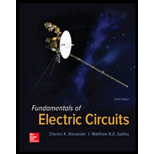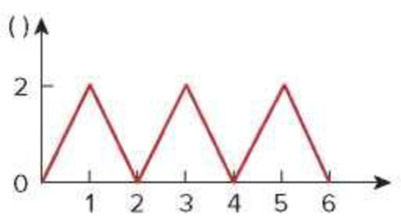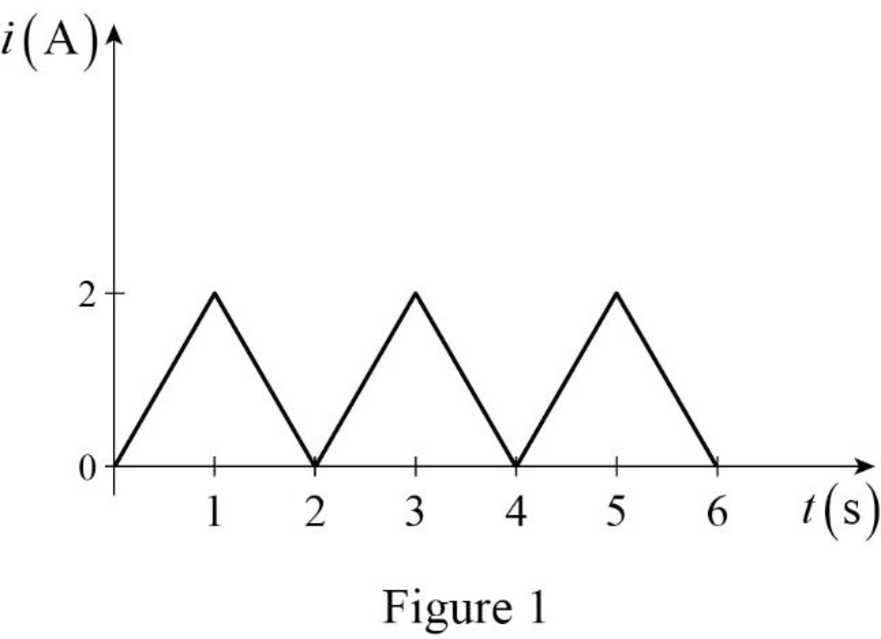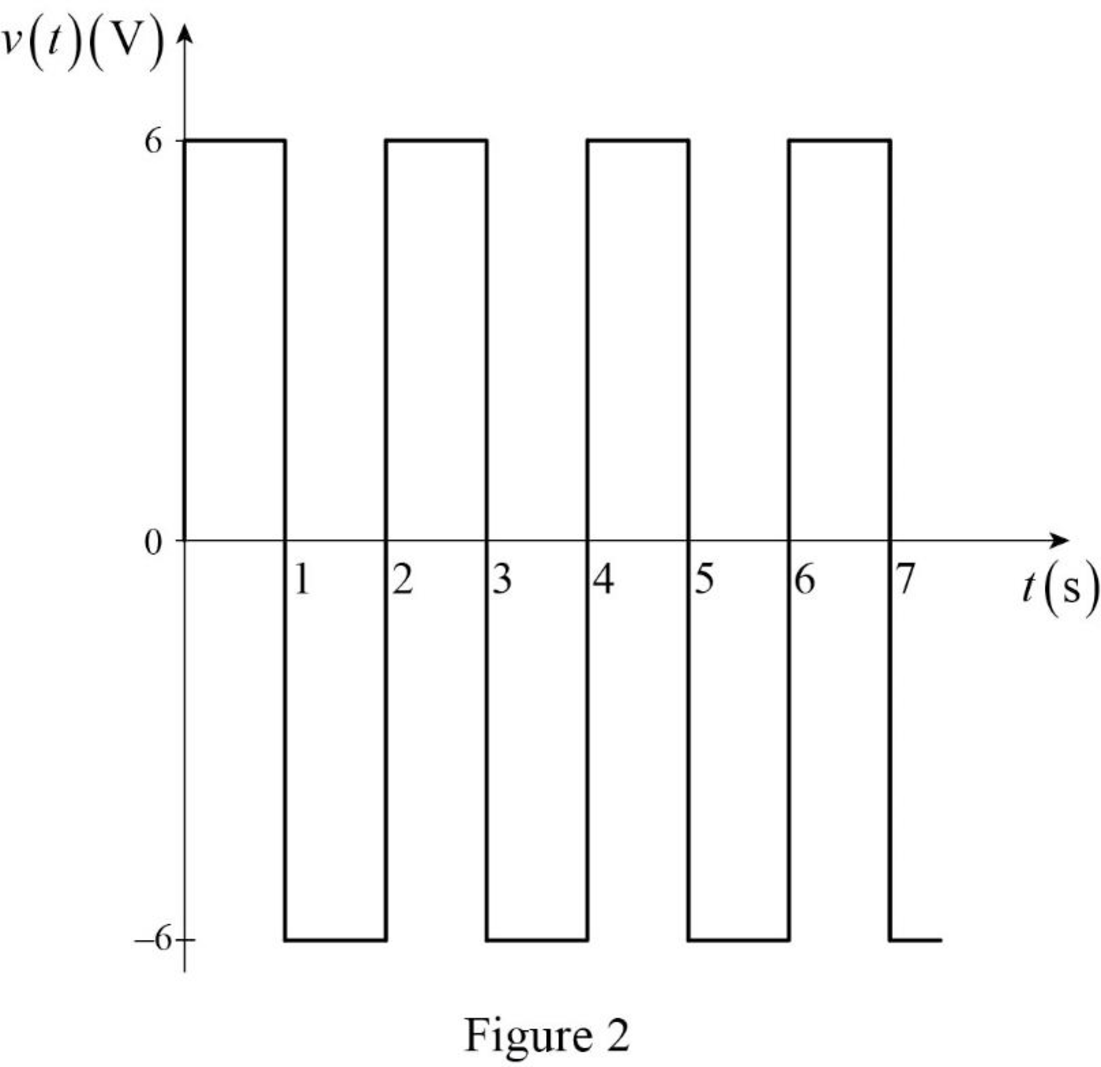
The current waveform in Fig. 6.80 flows through a 3-H inductor. Sketch the voltage across the inductor over the interval 0 < t < 6 s.

Figure 6.80
For Prob. 6.58.
Sketch the voltage across the inductor over the interval
Explanation of Solution
Given data:
The value of the inductor
Refer to Figure 6.80 in the textbook.
Formula used:
Write the expression to calculate the straight line equation for two points
Refer to Figure 6.80 in the textbook.
From the given graph, substitute
Write the expression to calculate the voltage across the inductor.
Here,
Calculation:
The given current waveform is redrawn as Figure 1.

Refer to Figure 1, split up the time period as six divisions
Case (i):
The two points
Substitute
Simplify the equation to find
Case (ii):
The two points
Substitute
Simplify the equation to find
Case (iii):
The two points
Substitute
Simplify the equation to find
Case (iv):
The two points
Substitute
Simplify the equation to find
Case (v):
The two points
Substitute
Simplify the equation to find
Case (vi):
The two points
Substitute
Simplify the equation to find
Therefore, the current function of the signal in Figure 1 is,
For
Substitute
For
Substitute
For
Substitute
For
Substitute
For
Substitute
For
Substitute
The expression of the voltage
From the voltage expression, the signal is drawn in Figure 2.

Conclusion:
Thus, the voltage across the inductor over the interval
Want to see more full solutions like this?
Chapter 6 Solutions
Fundamentals of Electric Circuits
- A 20-uF capacitor has a voltage of 5V across it at t=0. If a constant current of 30mA flows through the capacitor, how long will it take for the capacitor to charge up to 180 uC?arrow_forwardUse realistic inductor values from Appendix H to construct series and parallel combinations of inductors to yield the equivalent inductances specified below. Try to minimize the number of inductors used. Assume that no initial energy is stored in any of the inductors. 1. 8 mH; 2. 45 μH; 3. 180 μH.arrow_forwardTwo capacitors with 2.0 F and 3.0 F capacitance, respectively, are connected in parallel and subjected to total potential difference of 100 V. Find the (a) total capacitance, (b) charge stored in each capacitor, and (c) potential difference across each capacitor.arrow_forward
- Capacitance’s of 15μF, 12μF, 17μF, and 19μF are connected in parallel to a Direct Voltage Supply of 400V. Determine the: (A) Equivalent Circuit Capacitance, (B) Total Charge, and (C) Charge on each Capacitor.arrow_forwardCan somebody explain why the inductors are open circuit and the capacitor is short circuited. Given that: The presence of a voltage source indicates an infinite size, which may be stated in the circuit as Vs(t)= δ(t).arrow_forwardThree capacitors are connected in parallel across a 230 V, 60 Hz supply. These capacitors have values of 10 µF, 30 µF, and 60 µF, respectively. A single capacitor can replace the three capacitors. What value of capacitance is required to do this? Determine the total current taken by the three capacitors. What is the current in the 10 µF capacitorarrow_forward
- The voltage across a 5 μF capacitor is known to be vc=500te−2500t V for t≥0. Find the power at the terminals of the capacitor when t=100 μs.arrow_forwardA dc constant voltage source feeds a resistance of 2,000 kΩ in series with a 5µF capacitor. Find the time taken for the capacitor when the charge retained will be decayed to 50% of the initial value, the voltage sourcing being short circuited. Ans 11arrow_forward2. Suppose you want a capacitor bank with a total capacitance of 0.750 F and you possess numerous 1.50 mF capacitors. What is the smallest number you could hook together to achieve your goal, and how would you connect them?arrow_forward
- 10. Two inductors of 20 mH and 10 mH are connected in series carrying a current of 1 A. Find the total energy stored.arrow_forwardA 100-uF capacitor is charged by a constant current of 1mA. Find the voltage across the capacitor at t = 4s. Assume V(0) = 0 V.arrow_forwardA 125 F capacitor that has an initial voltage of 25 V is charged with a current that varies with time according to the equation I = t(t^2 + 6.83)^0.5 A . Find the voltage across the capacitor after 1 s.arrow_forward
 Introductory Circuit Analysis (13th Edition)Electrical EngineeringISBN:9780133923605Author:Robert L. BoylestadPublisher:PEARSON
Introductory Circuit Analysis (13th Edition)Electrical EngineeringISBN:9780133923605Author:Robert L. BoylestadPublisher:PEARSON Delmar's Standard Textbook Of ElectricityElectrical EngineeringISBN:9781337900348Author:Stephen L. HermanPublisher:Cengage Learning
Delmar's Standard Textbook Of ElectricityElectrical EngineeringISBN:9781337900348Author:Stephen L. HermanPublisher:Cengage Learning Programmable Logic ControllersElectrical EngineeringISBN:9780073373843Author:Frank D. PetruzellaPublisher:McGraw-Hill Education
Programmable Logic ControllersElectrical EngineeringISBN:9780073373843Author:Frank D. PetruzellaPublisher:McGraw-Hill Education Fundamentals of Electric CircuitsElectrical EngineeringISBN:9780078028229Author:Charles K Alexander, Matthew SadikuPublisher:McGraw-Hill Education
Fundamentals of Electric CircuitsElectrical EngineeringISBN:9780078028229Author:Charles K Alexander, Matthew SadikuPublisher:McGraw-Hill Education Electric Circuits. (11th Edition)Electrical EngineeringISBN:9780134746968Author:James W. Nilsson, Susan RiedelPublisher:PEARSON
Electric Circuits. (11th Edition)Electrical EngineeringISBN:9780134746968Author:James W. Nilsson, Susan RiedelPublisher:PEARSON Engineering ElectromagneticsElectrical EngineeringISBN:9780078028151Author:Hayt, William H. (william Hart), Jr, BUCK, John A.Publisher:Mcgraw-hill Education,
Engineering ElectromagneticsElectrical EngineeringISBN:9780078028151Author:Hayt, William H. (william Hart), Jr, BUCK, John A.Publisher:Mcgraw-hill Education,





